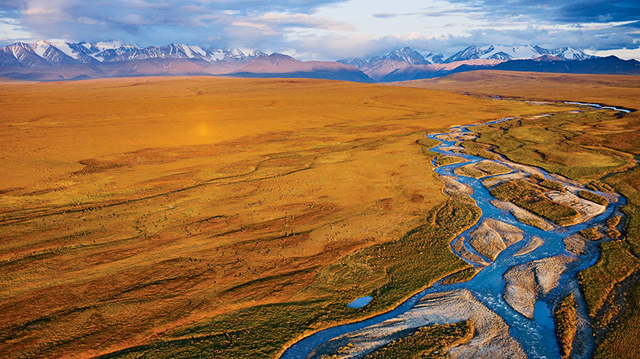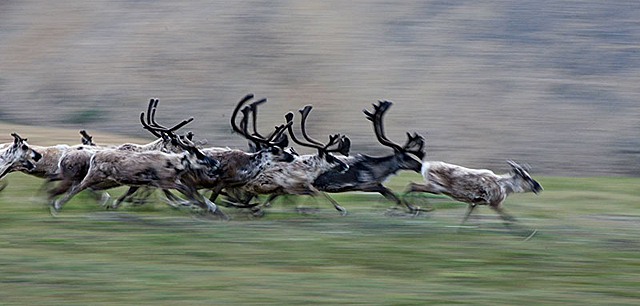sierraclub.org - sierra magazine - november/december 2010 - liberty, equality & caribou
Celebrating 50 years of the Arctic National Wildlife Refuge

The coastal plain of the Arctic Refuge is the preferred calving ground of the Porcupine caribou herd, and the preferred drilling ground of the oil industry. | Photo by Florian Schulz/Visions of the Wild
This December, we celebrate the improbable survival of the wildest of the wild. Fifty years ago, President Dwight D. Eisenhower established what was then called the Arctic National Wildlife Range to protect the "unique wildlife, wilderness and recreation values" of 8.9 million acres in far northeastern Alaska. In 1980, its size was doubled, and it was renamed the Arctic National Wildlife Refuge. Most was designated wilderness—with the exception of a strip of land north of the Brooks Range that is believed to harbor large deposits of oil.
Congress has fiercely debated whether to allow drilling there ever since. In 1995, President Bill Clinton's veto of a budget bill
that included drilling in the refuge led to a shutdown of the entire federal government. Just this spring, in the wake of the BP oil disaster, Sarah Palin claimed that her "drill, baby, drill" mantra actually referred to "safe onshore places like ANWR."
For the moment, the refuge is safe, and the vast migrations of caribou continue as they have for millennia. Environmental groups and Native people who depend on the caribou are still pushing for wilderness protection for the coastal plain, as well as for "resilient habitat" principles to be incorporated into the refuge's new management plan, now being drafted. "We've worked to protect the refuge for 50 years," says Sierra Club senior regional representative Dan Ritzman. "Now we're looking forward to the next 50 years, or 100 years. Because of climate change, this is one of the most-threatened habitats in the United States."
While the refuge officially celebrates its 50th birthday this year, the area's natural wonders have been championed since the 1920s—by pioneering conservationists Olaus and Margaret Murie, and later by Supreme Court Justice William O. Douglas, who called it "this last American living wilderness." In their footsteps comes author Terry Tempest Williams, who adapted the following essay for Sierra from her book The Open Space of Democracy (Orion Society, 2004). —Paul Rauber
The Open Space of Democracy
by Terry Tempest Williams

Caribou stream over mountain passes near the Hulahula River to the plains beyond. | Photo by Florian Schulz/Visions of the Wild
The Arctic is balancing on an immense mirror. The water table is visible. Pools of light gather: lakes, ponds, wetlands. The tundra is shimmering. One squints perpetually.
Drinking from the river—I am drinking from the river—this tincture of glaciers, this press of ice warmed by the sun. If water can pool in one's heart, then my heart is full. My arid heart has been waiting for decades, maybe three, for the return of this childhood pleasure of drinking directly from the source.
Drinking from the river. We all are. Ten pilgrims unaided. No iodine. No fancy filters or pumps, just the sweet dip of our cups from river to mouth, as much as we want, whenever we want. Our deep unmeasured thirsts are quelled.
When my father asks me what it was like to visit the Arctic National Wildlife Refuge, I will simply say, "We drank from the river."
Deep dreams. We awake to the distress cries of a lesser yellowlegs. For two hours, this bird is relentless. I finally resort to counting: ninety cries per minute. Brooke and I get up to see if we are camped by her nest but find nothing.
We walk the tundra behind us, up its terraces and steppes. We find bear tracks, caribou tracks, and a family of northern shrikes. We are bathed in light, endless light, sometimes volatile, ever changing. We watch weather as one watches fire.
I think of the Arctic National Wildlife Refuge as a place where the ongoing natural processes of life can continue without interference. Our evolutionary past and our future are secure here. This is the place where the press of humanity can be lifted in the name of restraint and where our species' magnanimous nature can be practiced. The Arctic becomes a breathing space. In the company of wild nature, we experience our own humble core of dependency on the land.
This is the open space of democracy. Raw, wild beauty is a deeply held American value. It is its own declaration of independence. Equality is experienced through humility. Liberty is expressed through the simple act of wandering.
I thought I saw a musk ox across the river. It was an empty oil drum.
3 a.m. Divine light. I am called out of my tent by the sun. I walk north blinded by its radiance. On top of the ridge, I see two of my fellow travelers. I wave. They wave back. One raises his arms above his head with bent elbows. I understand. Caribou.
My binoculars scan the landscape for several minutes. Heads, antlers, backs, tails, hooves, one caribou merges with another. Calves are jumping next to their mothers. It is an endless stream of animals walking across the tundra. Without my field glasses they register as a heat wave. I cannot take my eyes off of them.
One by one, members of our party rise from their tents. They rise to a rainbow and another. A double rainbow is arching over the plains in Arctic light, and we watch, as human beings have always watched, the great herds in motion.
Terry Tempest Williams is an author, a naturalist, and an environmental activist. Her most recent book is Finding Beauty in a Broken World (Vintage Books, 2009).
This article was funded by the Sierra Club's Resilient Habitats program.